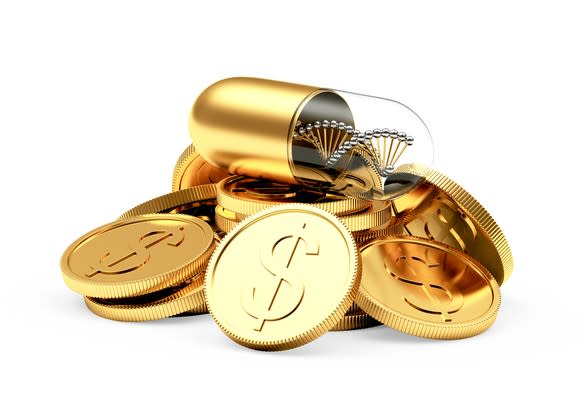3 High-Yield Stocks at Rock-Bottom Prices
Often, dividend yields soar because a company's share price is falling thanks to a business in disrepair. That can make buying high-yield stocks risky, so it pays to be selective and focus only on businesses that have the best odds of getting back on track. With that in mind, we asked some of our top Motley Fool investors if there were any of these companies on their radars, and they said "yes!" Read on to find out why it might be a smart time to add L Brands (NYSE: LB), GameStop Corp. (NYSE: GME), and AbbVie, Inc. (NYSE: ABBV) to income portfolios now.
A fat retail dividend
Tim Green (L Brands): There's no shortage of retailers currently struggling to grow sales and maintain margins. L Brands, which owns Victoria's Secret, Bath & Body Works, and a few other brands, suffered from a period of slumping comparable sales in 2016 and 2017. But its fourth-quarter results were better than expected, with both comparable sales and adjusted earnings moving in the right direction.

IMAGE SOURCE: GETTY IMAGES.
Fourth-quarter comparable sales jumped 2%, while adjusted earnings per share rose 4%. Victoria's Secret suffered a sales decline, but sales growth from Bath & Body Works picked up the slack. It's hard to say whether the company can sustain this growth, but for now, things are looking up.
L Brands pays a quarterly dividend of $0.60 per share, which works out to a yield of about 6.4%, one of the highest in the S&P 500. A slumping stock price over the past few years is responsible for the soaring yield. Since peaking in late 2015, the stock has tumbled roughly 62%. Based on the mid-point of the company's adjusted earnings guidance for this year, the stock sports a price-to-earnings ratio of just 12.
The dividend does eat up 77% of adjusted earnings based on the guidance, which is high enough to be concerned that a dividend cut could be in the cards if earnings growth doesn't pick up. That's a risk you'll have to take if you want a yield that's more than triple that of the S&P 500.
Be careful what you wish for
Rich Smith (GameStop): So you say you want a stock with a really high dividend yield and a rock-bottom price? Well, I've got good news and bad news. The good news is that when a stock gets well and truly creamed, knocking its price down to a multiyear low, its dividend will probably look really big relative to that really low stock price.
In the case of GameStop, that's also the bad news.
With an 11.2% dividend yield, GameStop is one of the 100 top dividend paying companies on the stock market today -- a pretty incredible statistic for a pretty run-of-the-mill retailer. The problem is, the way GameStop achieved its top dividend payer status was not just by increasing the amount of dividends it pays (although it has done that). At the same time as it's been growing its dividend, though, GameStop's stock price has been shrinking pretty dramatically, inflating its dividend yield as a result. Currently priced below $14 a share, GameStop is selling for a price last seen in 2005 -- a near-13-year low. The question for dividend seekers is whether it can (and will) continue paying out so much wealth in dividends.
Can it continue to pay out so much money as dividends? I think so. GameStop's payout ratio remains a very reasonable 44%. Will it continue paying? I think the answer there, too, is yes. In fact, GameStop CFO Robert Lloyd expressed a commitment to "continue to prioritize shareholder returns" when GameStop reported fourth-quarter earnings last week. Still, I could be wrong about that.
And if I am wrong, and GameStop does eventually cut its high-yield dividend, I fear investors will see today's rock-bottom stock price fall even lower.

IMAGE SOURCE: GETTY IMAGES.
A beaten-down biopharma with a top-tier dividend yield
Todd Campbell (AbbVie): Recently, AbbVie rolled out disappointing data for one of its most prized clinical-stage drugs, Rova-T. The overall response rate to Rova-T in heavily pretreated small cell lung cancer patients was only OK, and as a result, hopes to see it secure an accelerated OK ahead of phase 3 trials were dashed.
The Rova-T news sent AbbVie's shares reeling and, in turn, its dividend yield soaring. As of this writing, buyers are being rewarded with a healthy, market-beating 4.1% dividend rate.
The risk of buying any beat-up dividend stock is that further declines in share price will more than offset any income the company pays out. No one knows what will happen next for AbbVie, but Rova-T isn't the only drug management is counting on to fuel future growth. It plans to file for FDA approval soon for upadacitinib, a rheumatoid arthritis drug, and risankizumab, a psoriasis drug, and the peak sales projections for those two drugs alone exceeds $11 billion.
AbbVie could also benefit from ongoing sales growth for its blood-cancer drug, Imbruvica, which was recently approved for use in graft-versus-host disease, and the potential approval of its endometriosis drug, elagolix, which could add another billion in sales. There's also a chance that label expansions will turn its multiple myeloma drug, Venclexta, into a blockbuster someday.
Additionally, it may not be game-over for Rova-T. Phase 3 trials are continuing, and since the 5-year survival rate in late-line small cell lung cancer is in the low single-digit percentages, the bar is set low for those trials to be considered successful.
Ultimately, AbbVie's biggest risk is the threat of biosimilar competition to its best-seller, Humira. Humira's patents are expiring in the EU this year, so it will face some headwinds, but following a positive patent decision last year, Humira may not have to fight off competitors in the U.S. until 2023. As a result, AbbVie's still got some time to maneuver.
Overall, I think AbbVie's other R&D programs suggest now is a good time to start picking up shares and pocketing its market-beating dividend yield.
More From The Motley Fool
Rich Smith owns shares of GameStop. Timothy Green has no position in any of the stocks mentioned. Todd Campbell has no position in any of the stocks mentioned. His clients may have positions in the companies mentioned. The Motley Fool owns shares of GameStop and has the following options: short April 2018 $18 calls on GameStop. The Motley Fool has a disclosure policy.
